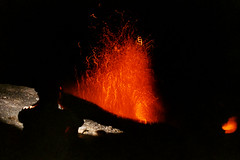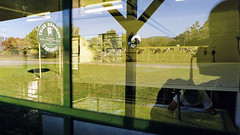

| Archive Blog Cast Forum RSS Books! Poll Results About Search Fan Art Podcast More Stuff Random |
|
Classic comic reruns every day
|
1 {photo of samples of wine in flasks}
1 Caption: Acids and Bases
|
First (1) | Previous (3231) | Next (3233) || Latest Rerun (2895) |
Latest New (5380) First 5 | Previous 5 | Next 5 | Latest 5 Annotations theme: First | Previous | Next | Latest || First 5 | Previous 5 | Next 5 | Latest 5 This strip's permanent URL: http://www.irregularwebcomic.net/3232.html
Annotations off: turn on
Annotations on: turn off
|
 Do chemistry - this might happen! |
Chemistry involved Bunsen burners and heating things up, which always, according to my teacher, carried the risk of doing it wrong and splashing hot acid or whatever it was all over your face. You could mix things wrong, or measure them wrong, and your experiment wouldn't work. And reactions generated weird gases that could kill you if you inhaled them, so you had to use fume cupboards to avoid dying right there and then in your science classroom. Chemistry was a dangerous, inexact, difficult, mess that didn't work half the time. And the theory side of it was the dull balancing of reaction equations, which would have been trivially simple algebra if not for the seemingly completely arbitrary additional rules concerning valences that were apparently added for no other reason than to make it harder.
 Volcanoes. Much safer. |
It was somewhere in between this and high school that chemistry lost its lustre and planets became the coolest thing ever. Perhaps it was fortunate I didn't get to play with real planets, since the mystery and unattainability of actually visiting another planet kept them alive in my mind like some sort of forbidden fruit. Thinking about it now, I guess Star Wars didn't hurt either.
It wasn't until I got to university that I started to appreciate chemistry again. The reason, I think, is because that up until then chemistry seems to be more or less arbitrary rules that you just have to know. To understand why those rules exist, you have to dig deeper than high school science allows. You need to appreciate some of the intricacies of quantum mechanics, which dictates things like the numbers of electrons in the shells of atoms.[2] I should say that I skipped HSC chemistry (what some readers might think of as senior high school, or A level chemistry) because I disliked it that much, so probably some of that stuff was taught then. Imagine my horror when I got to university and discovered that for the degree I'd chosen, a year of chemistry was mandatory.
 Those mysterious numbers. |
That's the way we were taught it in school. pH goes from 0 to 14, and neutral is right in the middle at 7. But why these numbers? Did some ancient chemist just decide 7 was his favourite number and go from there?
Water consists of molecules, each one containing two atoms of hydrogen, bonded covalently to one atom of oxygen (thus the descriptor which even many non-chemists know: H2O). Water is a really good solvent, which means that it's really good at dissolving things. Dissolving is actually the breaking apart of chemical bonds between atoms. When you drop some table salt into water, the water acts to pull apart the sodium and chlorine ions present in the salt crystals, and gently separates them. Salty water is water with a bunch of free floating, loose ions of sodium and chlorine distributed through it. (I talked about ions briefly here when discussing ionic chemical bonding. That annotation also mentions covalent bonding.) Something like sugar is actually very different from salt, being made of quite large, covalently bonded molecules. These molecules assemble into the crystal structures we know as sugar crystals through a secondary, weaker bonding between the molecules. When sugar dissolves, the water pulls apart the weaker bonds, separating the sugar into individual molecules - but the molecules remain whole. As I said, water is really good at pulling other chemical compounds apart like this. Many, many chemical compounds dissolve in water, either into ions, or into separated molecules.
Even water dissolves in water a little bit.[3] The atoms of a water molecule can be pulled apart into a hydrogen ion (symbol H+) and what's called a hydroxide ion (symbol OH-). A hydrogen ion is a hydrogen atom with its only electron stripped off; in other words, it's a bare proton all by itself. A hydroxide ion is, as the name suggests, a hydrogen atom bonded to an oxygen atom, but with an imbalance in electric charge. Hydroxide ions have nine protons - one in the hydrogen atom and eight in the oxygen atom - but ten electrons, giving them an overall negative charge.
 Mole Creek Karst caves. Another sort of mole, and these formations are produced by... acid. |
Now, if you take pure water (with part of it dissolved into ions), and add some more hydrogen ions somehow, then the excess of H+ ions will force some of them to combine with some of the OH- ions, thus reducing the concentration of hydroxide ions a bit. The resulting solution has slightly more H+ ions than pure water, but slightly fewer OH- ions than pure water. As it happens, the balancing point is determined mathematically by the following relationship: The concentrations of H+ ions and OH- ions, when multiplied together, always give the same number. As a simple example, if a volume of pure water contains 2 moles of H+ ions and 2 moles of OH- ions, then if you add 3 moles of H+ ions here's what happens: 1 mole of the H+ ions combines with 1 mole of the OH- ions to give water molecules. This leaves 1 mole of OH- ions and 4 moles of H+ ions, and the product
(1 mole OH-)×(4 moles H+) = (2 moles OH-)×(2 moles H+)This example is a little fuzzy because the extra water has been ignored - it's just to give you the idea of how the concentrations of H+ and OH- always multiply to give you the same number. And in fact the number, if expressed in terms of moles per litre, isn't nearly as big as 4. At room temperature it's actually very close to 0.00000000000001. In scientific notation, this is 10-14. So in a glass of pure water at room temperature, the concentrations of both the H+ and OH- ions are very close to 10-7 moles per litre each, since 10-7 × 10-7 = 10-14.
 Wine fermentation vats. A practical use of acidity and careful pH measurement. |
If you add hydrogen ions to pure water - for example by adding the compound HCl, or hydrogen chloride - the concentration of H+ ions increases, and the concentration of OH- ions decreases in proportion. For example, the H+ concentration might increase as high as 10-2 moles per litre, pushing the OH- concentration down to 10-12 (the product if you multiply these together is still 10-14). So the H+ concentration of this resulting solution of hydrochloric acid is 10-2. What's its pH?
If you said "2", well done. If you add more HCl, you can get the H+ concentration as high as 10-1 or even 10-0 - and these acid solutions have pH of 1 and 0 respectively.
On the other hand, if you start with pure water and add hydroxide ions - for example by adding the compound NaOH, or sodium hydroxide - the concentration of OH- ions increases, and the concentration of H+ ions decreases in proportion. For example, the OH- concentration might increase as high as 10-2 moles per litre, pushing the H+ concentration down to 10-12 (the product if you multiply these together is still 10-14). So the H+ concentration of this resulting solution of sodium hydroxide is 10-12. What's its pH?
 Cheesemaking. Also an application of acid - mixed with milk to make curds. |
And that is why the pH scale ranges from 7 for neutral, to lower numbers for acids, and higher numbers for bases/alkalis.
Some interesting additional facts:
[2] Some may argue that the rules of quantum mechanics are just as arbitrary, if not more so. On reflection, I can certainly understand that point of view, and to some extent agree with it. When learning all of this stuff for the first time though, I was willing to take on board the rules of quantum mechanics more readily. Possibly because it was more divorced from everyday reality than chemistry, so I figured there was little point questioning them too much. Of course, other scientists do question those rules as well, and so we delve ever deeper into the mysteries of how the universe works. This is why we build things like the Large Hadron Collider. Because we as a society aren't satisfied with being given arbitrary rules by nature.
[3] The word "dissolve" here is being used loosely and figuratively. Technically the water molecules dissociate.
[4] If you're curious, a mole was originally defined so that a mole of hydrogen atoms had a total mass of 1 gram. This meant that a mole of any one type of atom had a mass in grams equal to that atom's relative atomic weight compared to hydrogen. For example, oxygen has an atomic weight of 16, so a mole of oxygen atoms has a mass of 16 grams. This worked to the accuracies then known, but later definitions tweaked things slightly and this relationship is now a close approximation rather than being exact.
|
LEGO® is a registered trademark of the LEGO Group of companies,
which does not sponsor, authorise, or endorse this site. This material is presented in accordance with the LEGO® Fair Play Guidelines. |